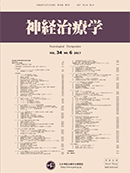40 巻, 3 号
選択された号の論文の88件中51~88を表示しています
シンポジウム3:NMOSDに対する生物学的製剤治療の現状と課題
-
2023 年 40 巻 3 号 p. 283-286
発行日: 2023年
公開日: 2023/08/21
PDF形式でダウンロード (422K) -
2023 年 40 巻 3 号 p. 287-291
発行日: 2023年
公開日: 2023/08/21
PDF形式でダウンロード (1052K) -
2023 年 40 巻 3 号 p. 292-294
発行日: 2023年
公開日: 2023/08/21
PDF形式でダウンロード (361K)
シンポジウム4:重症筋無力症の新たな治療戦略
-
2023 年 40 巻 3 号 p. 295
発行日: 2023年
公開日: 2023/08/21
PDF形式でダウンロード (248K) -
2023 年 40 巻 3 号 p. 296
発行日: 2023年
公開日: 2023/08/21
PDF形式でダウンロード (227K) -
2023 年 40 巻 3 号 p. 297
発行日: 2023年
公開日: 2023/08/21
PDF形式でダウンロード (201K) -
2023 年 40 巻 3 号 p. 298-300
発行日: 2023年
公開日: 2023/08/21
PDF形式でダウンロード (340K) -
2023 年 40 巻 3 号 p. 301
発行日: 2023年
公開日: 2023/08/21
PDF形式でダウンロード (210K)
シンポジウム5:多発性硬化症(MS)の最新治療戦略
-
2023 年 40 巻 3 号 p. 302
発行日: 2023年
公開日: 2023/08/21
PDF形式でダウンロード (282K) -
2023 年 40 巻 3 号 p. 303
発行日: 2023年
公開日: 2023/08/21
PDF形式でダウンロード (161K) -
2023 年 40 巻 3 号 p. 304-306
発行日: 2023年
公開日: 2023/08/21
PDF形式でダウンロード (753K) -
2023 年 40 巻 3 号 p. 307-310
発行日: 2023年
公開日: 2023/08/21
PDF形式でダウンロード (461K) -
2023 年 40 巻 3 号 p. 311-314
発行日: 2023年
公開日: 2023/08/21
PDF形式でダウンロード (505K)
シンポジウム6:脊髄小脳変性症とその周辺疾患:最近のトピックス
-
2023 年 40 巻 3 号 p. 315
発行日: 2023年
公開日: 2023/08/21
PDF形式でダウンロード (232K) -
2023 年 40 巻 3 号 p. 316-319
発行日: 2023年
公開日: 2023/08/21
PDF形式でダウンロード (876K) -
2023 年 40 巻 3 号 p. 320-323
発行日: 2023年
公開日: 2023/08/21
PDF形式でダウンロード (397K) -
2023 年 40 巻 3 号 p. 324-327
発行日: 2023年
公開日: 2023/08/21
PDF形式でダウンロード (399K) -
2023 年 40 巻 3 号 p. 328-333
発行日: 2023年
公開日: 2023/08/21
PDF形式でダウンロード (1871K)
シンポジウム7:炎症性ミオパチーの病態と治療
-
2023 年 40 巻 3 号 p. 334
発行日: 2023年
公開日: 2023/08/21
PDF形式でダウンロード (292K) -
2023 年 40 巻 3 号 p. 335-339
発行日: 2023年
公開日: 2023/08/21
PDF形式でダウンロード (1630K) -
2023 年 40 巻 3 号 p. 340-344
発行日: 2023年
公開日: 2023/08/21
PDF形式でダウンロード (669K) -
2023 年 40 巻 3 号 p. 345-348
発行日: 2023年
公開日: 2023/08/21
PDF形式でダウンロード (436K) -
2023 年 40 巻 3 号 p. 349-350
発行日: 2023年
公開日: 2023/08/21
PDF形式でダウンロード (338K)
シンポジウム8:進行期Parkinson病の治療戦略
-
2023 年 40 巻 3 号 p. 351
発行日: 2023年
公開日: 2023/08/21
PDF形式でダウンロード (257K) -
2023 年 40 巻 3 号 p. 352-354
発行日: 2023年
公開日: 2023/08/21
PDF形式でダウンロード (368K) -
2023 年 40 巻 3 号 p. 355-358
発行日: 2023年
公開日: 2023/08/21
PDF形式でダウンロード (1606K) -
2023 年 40 巻 3 号 p. 359-362
発行日: 2023年
公開日: 2023/08/21
PDF形式でダウンロード (553K) -
2023 年 40 巻 3 号 p. 363-367
発行日: 2023年
公開日: 2023/08/21
PDF形式でダウンロード (1387K)
シンポジウム9:自己免疫性脳炎のトピックス
-
2023 年 40 巻 3 号 p. 368-376
発行日: 2023年
公開日: 2023/08/21
PDF形式でダウンロード (1835K) -
2023 年 40 巻 3 号 p. 377-384
発行日: 2023年
公開日: 2023/08/21
PDF形式でダウンロード (872K) -
2023 年 40 巻 3 号 p. 385-390
発行日: 2023年
公開日: 2023/08/21
PDF形式でダウンロード (470K) -
2023 年 40 巻 3 号 p. 391
発行日: 2023年
公開日: 2023/08/21
PDF形式でダウンロード (185K)
臨床研究
-
2023 年 40 巻 3 号 p. 392-396
発行日: 2023年
公開日: 2023/08/21
PDF形式でダウンロード (825K)
治療経験レポート
-
2023 年 40 巻 3 号 p. 397-400
発行日: 2023年
公開日: 2023/08/21
PDF形式でダウンロード (335K)
総説
-
2023 年 40 巻 3 号 p. 401-406
発行日: 2023年
公開日: 2023/08/21
PDF形式でダウンロード (1702K)
-
2023 年 40 巻 3 号 p. 407-410
発行日: 2023年
公開日: 2023/08/21
PDF形式でダウンロード (341K) -
2023 年 40 巻 3 号 p. 411
発行日: 2023年
公開日: 2023/08/21
PDF形式でダウンロード (148K) -
2023 年 40 巻 3 号 p. 412
発行日: 2023年
公開日: 2023/08/21
PDF形式でダウンロード (133K)
